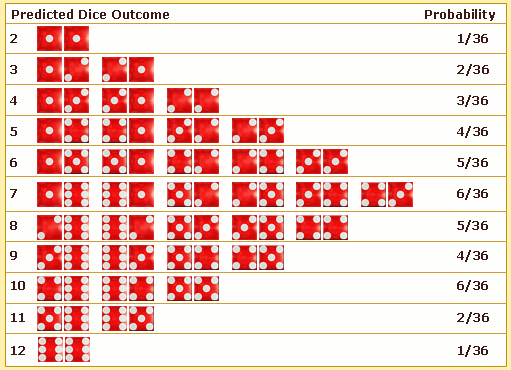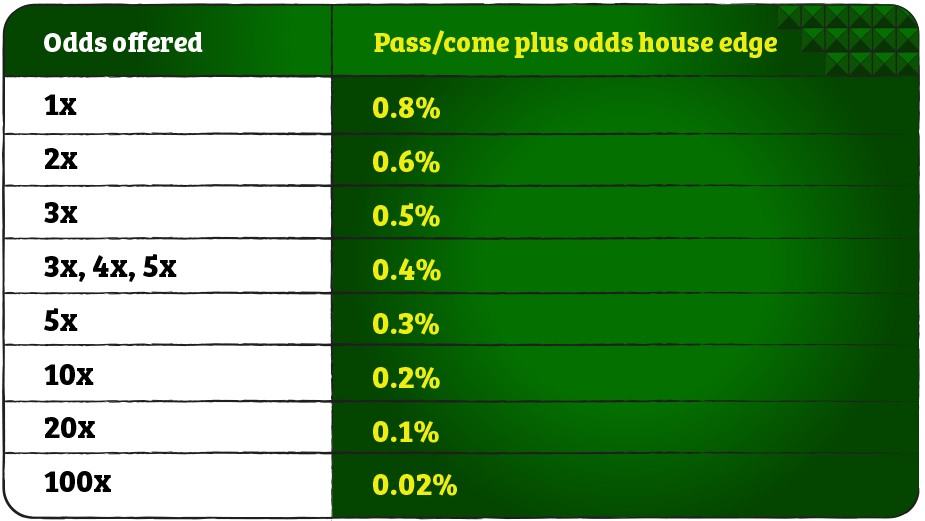As you know, craps is played with two dice. (By the way, the little dots on a die are called “pips.” A pip is simply a dot that symbolizes numerical value. You find pips on things like dice and dominoes.) Thirty-six (36) combinations of numbers can be rolled with two dice. Refer to the table below. Combinations Using Two Dice. Craps is always played with two dice, each of which is shaped like a cube less than an inch wide. Unlike the dice you’ll buy at your local game store for board games or RPGs, the dice used in craps have sharp edges and pointed corners. Craps dice are also bigger than the dice you’ll find in a game like Yahtzee or Monopoly.
Lexicon is very important when playing craps, as you will hear these terms expressed at the table and you can easily get lost and confused and therefore intimidated if you don't understand what they mean.
There is, for example, terminology related to the three different types of combinations that can be rolled at the craps table:
- A NATURAL refers to a total that is 7 or 11
- The POINT is a 4, 5, 6, 8, 9 or 10
- CRAPS is a total of 2, 3 or 12
The game of craps essentially revolves around the SHOOTER (who throws the dice) establishing the POINT, then wagers that concern themselves with whether a 7 or 11, or CRAPS is rolled before that point number is made again.
The COME-OUT ROLL is really any roll (and there may be more than one) that is made before the point is established. For the point to be established, a roll has to produce a total from the list of points above -- 4, 5, 6, 8, 9 or 10.
For example, if the come-out roll, produces a six (6), that is the POINT. Then the players can bet on whether or not another six will be rolled before the shooter throws a seven (7).
Players also make PASS LINE bets, which will be explained. If a NATURAL (7 or 11) is rolled before the point is established, the Pass Line bettors WIN. If CRAPS (2, 3 or 12) is rolled before the point is established, Pass Line bettors LOSE.
So if the shooter rolls a 7 on the come-out, everyone with a bet on the Pass Line wins. When the point has been established, and a 7 rolls before that particular point is rolled again, all the Pass Line bets lose, and the shooter is replaced. The dice are then generally given to the next person clockwise at the table. Any player, when offered the dice, can choose not to roll, at which point he or she just says 'pass' to the dealer and the next person will become the shooter.
One quick thing to note - if you do elect to become the shooter, you must bet the PASS or DON'T PASS before throwing the dice the first time.
You can walk into the game and know what the point is by finding the PUCK, a round disc-like marker that is placed on the point number. The puck has a white side and a black side. When the white side is up, the point is 'live,' so to speak. When the black side is up, the point has been made or a new point is yet to be established.

Best Craps Bonuses
These bonuses allow you to play craps to clear the bonuses wagering requirements.

- 3Dice Casino
110% Up To $100
Rating
3.6/53.7/53.5/53.6/5


- Intertops Casino Classic
100% Up To $/€100
Rating
4.3/54.4/54.2/54.3/5
Craps Dice Combos Poker
- SlotJoint Casino
200% Up To €40
Rating
4.0/54.1/53.9/54.0/54.0/5
Craps Dice Combos Hack
How to Play Craps
That's right. There are exactly six different axial sets. Again, the only difference is which number the shooter chooses to have 'up' or 'facing down table.' For simplicity sake I have arranged the sets in the chart below showing the axial faces of the individual sets. Remember, the axial set refers to the numbers showing on the SIDES (left/right) of each individual die prior to the toss. The objective is to toss the dice 'on axis' - as if there were a steel rod driven through the two dice like an automobile axle. The dice tumble or roll forward without any excessive bouncing, pitch, yaw, etc. Granted, the toss is a challenge, but you only have to control one roll out of 43 to turn the odds in your favor. Let's look at the 34-34 set first - the left die will have the 3 on the left face and the 4 on the right face. The right die will have the 3 on the left face and the 4 on the right face. If you have a pair of dice get them out and orient them like this. For the sake of this example, let's put the hard ten facing up - the twelve facing your chest, the hard four facing down - and the aces facing toward the computer screen. This is a preferred set for the come out roll. Why? Look at the distribution of numbers it yields when rolled on axis. There are four ways to make the seven and two ways to make the eleven. Instead of 8 naturals out of 36 combinations on a random roll - you have 6 naturals out of 16 combinations. The math of this should be obvious, even to those handicapped by advanced degrees. Okay, let's assume you throw five naturals before establishing a point - which turns out to be a ten. What do you do next? You have your choice of two axial sets. The first is the 52-52, which provides you with two ways to hit the ten when rolled on axis. But look at the incidence of sevens in this combination. There are four ways to make the sevens with this set - when rolled on axis. So a better choice is to switch to the 34-16 set - which reduces the incidence of the seven to two ways. Suddenly, instead of having 2-1 odds against winning on the ten - it is an even money bet. Suddenly, you have a 2-1 ADVANTAGE over the house on the free odds bet on the ten. That, my friend, is what dice setting and controlled rolling is all about.
|
